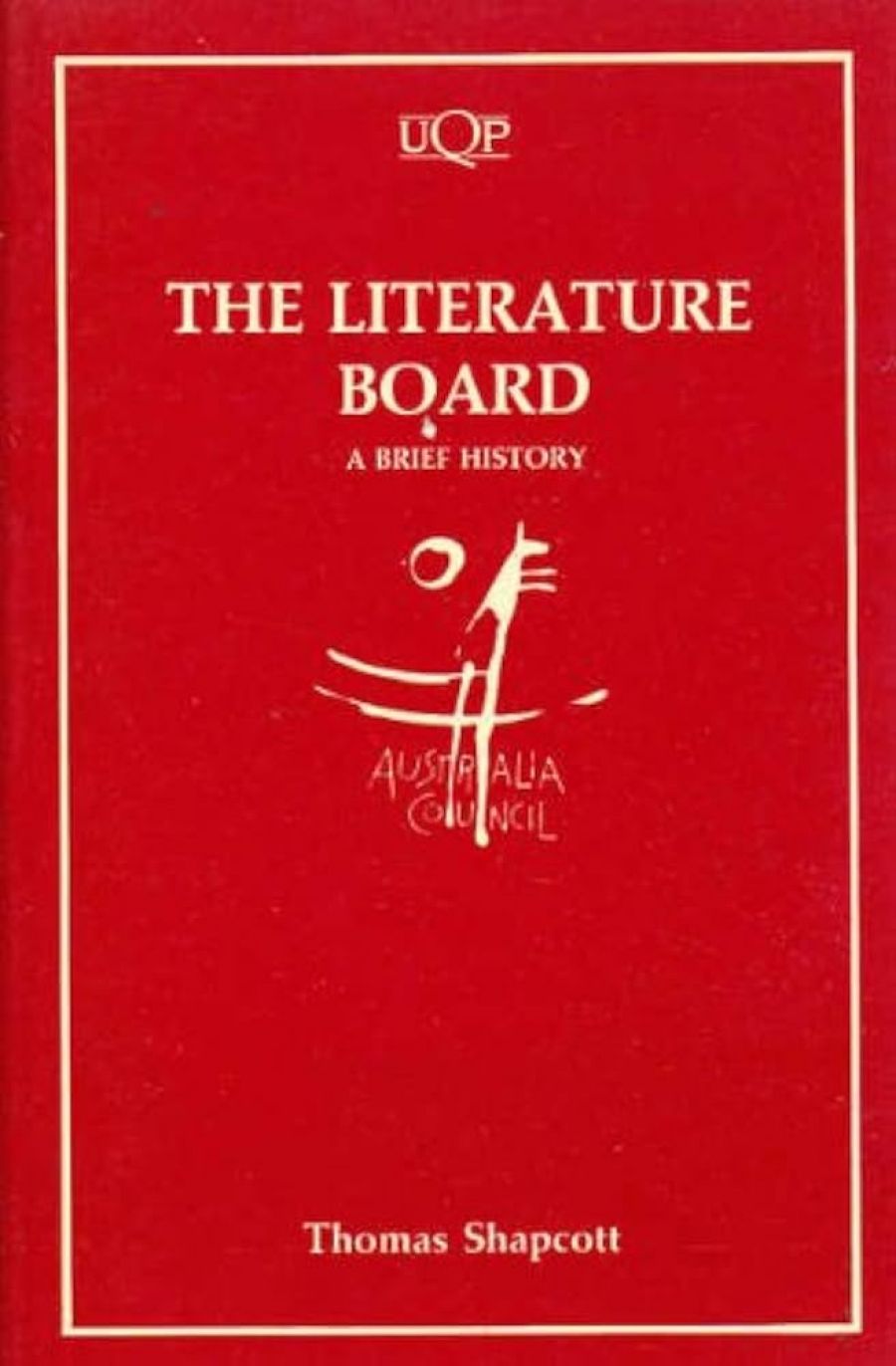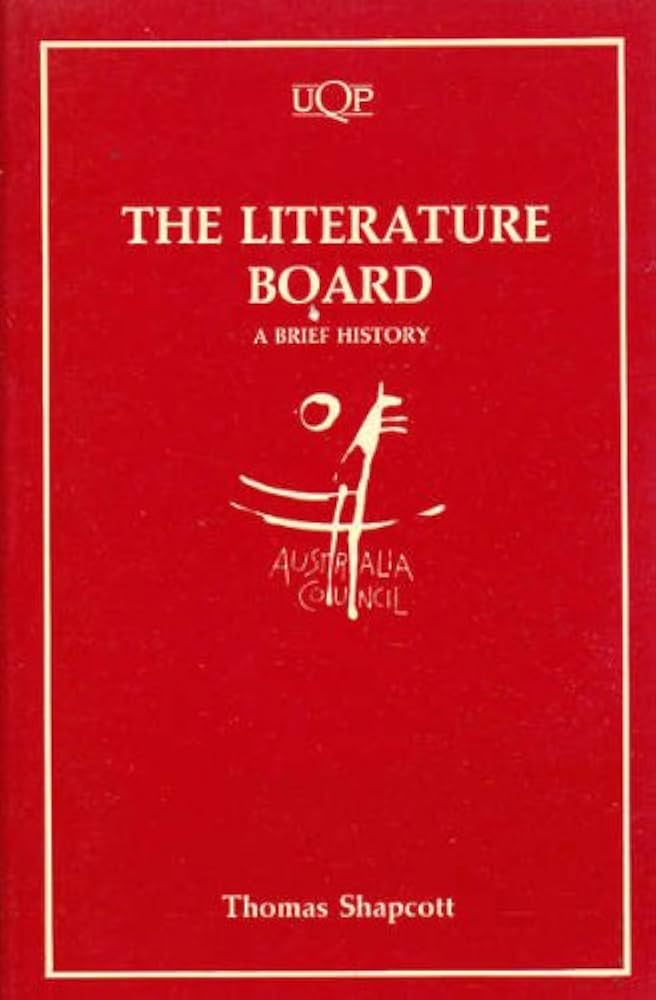
- Free Article: No
- Contents Category: History
- Review Article: Yes
- Article Title: Es tu, Leonie?
- Online Only: No
- Custom Highlight Text:
I took the sub-title of Tom Shapcott’s book to be mildly ironic. His ‘brief history’ is not brief, nor is it a history in the conventional sense. It is a hefty compilation of lists– lists of writers assisted by the Literature Board, lists of projects, lists of payments and awards to authors, lists of publications –together with long extracts from official reports, board minutes and documents of various kinds, all impressively tabulated and cross-referenced, with codes and file numbers in abundance. And at first sight it looks pretty dull. Surely a prose narrative would have brought the story more vividly to life? Surely Tom Shapcott, the Board’s respected director since 1983, could have presented this laborious aggregation of data in more digestible form, enlivening his history with the occasional sharp anecdote, dwelling here on a notorious personality, here on a clash of wills, here perhaps on the tiny scandal or neglected cause celebre?
- Book 1 Title: The Literature Board: A Brief History
- Book 1 Biblio: University of Queensland Press, 320 pp
- Book 1 Cover Small (400 x 600):

- Book 1 Cover (800 x 1200):

The Board, of course comes out of it well. With a few obvious exceptions, it is difficult to think of a contemporary Australian writer of any note whose name is not somewhere included. In 1972, the year before the Board was established (in succession to the old Commonwealth Literary Fund), nineteen novels were published in Australia; in 1986 the number was more than two hundred. In fifteen years the Board has distributed S23 million in grants, more than half of it in payments to individuals, the rest in subsidies to magazines and publishing companies and in promotional activities. Individual success stories are listed. A Literature Board grant made possible the publication of A. B. Facey’s A Fortunate Life, and there is another list of works written with the Board’s assistance that have been made into films or television serials: Carey’s Bliss, McDonald’s 79/5, Koch’s The Year of Living Dangerously, and more. The Board’s success in promoting Australian writing abroad, in supporting poetry, drama and Aboriginal writing are amply documented. It is beyond question that our writers are now more prolific, their incomes a little more secure and their books, if not more likely to be read, are at least more likely to be published, promoted, reviewed, and prescribed for study in schools and universities. And for this we have the Board to thank.
At this point, perhaps, I should declare an interest. I have worked closely with Shapcott and the Literature Board over a number of years; I have collaborated in various projects; I share their sympathies and admire their work. The New South Wales arts ministry has attempted in a more modest way to do many of the things the Board has done. But I doubt whether Shapcott’s book will silence the Board’s critics. Those who consider ‘grants’ a dirty word and regard all public support for artists as a waste of money are unlikely to be persuaded otherwise by detailed documentation of the Literature Board’s largesse.
It is a pity Shapcott has not offered some reasoned argument for the philosophy of public subsidy. He may not have considered it necessary. But the case is by no means self-evident, despite Tom’s facts and figures, and there are ominous signs that public attitudes are changing. In1973, when the Whitlam government was setting up the Australia Council and we were making the first appointments to its Boards, public opinion was more sympathetic to the funding of literature and the arts than it is now. Arts funding budgets are contracting. Governments are more sensitive to accusations of waste and extravagance. Tighter fiscal policies and more conservative attitudes among all political parties to welfare spending and public enterprise are putting greater pressure on the budgets of the Literature Board and similar agencies. Already the Board has been forced to cut back the number of its fellowships, and the administrative budget of the Australia Council has been drastically squeezed.
Shapcott is most effective in demolishing the belief that many writers want to grab the money and run. The success rate among assisted writers, we are told, is ‘almost staggeringly high – far higher than recipients of tertiary education scholarships’. And the statistics bear this out. In a somewhat whimsical postscript, Shapcott cheerfully tells the story of the Melbourne playwright who ‘boasts that he once got a grant by showing a photo of his empty fridge’. He concedes that a certain number of grant recipients show ‘married’ on the application form one year and ‘not married’ next time round, and goes on
One writer used the money to buy a washing machine. It helped her save time and thus write some short stories that were subsequently published to great acclaim; indeed she has been published in the New Yorker. And a Sydney poet claimed he bought a fast car with his grant – and then smashed it up almost instantly! But he, too, went on to publish his three or four most significant books on the time that the Literature Hoard money gave him to get on with his writing.
All this is recounted with a straight face. It is the sort of material a political ‘Waste Watch’ committee might relish, but Shapcott isn’t greatly fussed about it. And nor should he be. The occasional embarrassment– even the odd case of genuine abuse – is the price paid for any publicly-funded arts program. But there are more sophisticated arguments against public support for writers that deserve more attention. One is the view that grant-giving bureaucracies constitute a self-perpetuating literary mafia whose patronage is disbursed to likeminded coteries. I have looked carefully through Shapcott’s book and there is no evidence whatever that this is so. Indeed, it is one of the virtues of his chosen format that such charges can be refuted on the facts. The Board’s grants have been distributed to writers across the social and political spectrum; the membership of the Board itself has reflected a diversity of views. And if the Board is to maintain its authority and reputation it is essential that this should be so. (The NSW Government has taken the same view when choosing judges for the Premier’s Literary Awards. Our judging committees have rarely been unanimous, and occasionally their decisions have disappointed me; but no one has ever accused them of bias, cronyism or perversity.)
Shapcott has little time for the more cynical view that literary subsidies promote mediocrity. For those who believe this, his lists and statistics will serve only to confirm their prejudices; numbers here are the proof of the pudding. Pointing wistfully to a golden age when writers produced their masterpieces without help from the State, the smilers and scourgers of mediocrity still solemnly insist that too many books are being written, that too many novels are being published. And the idea that struggling authors are somehow ennobled and improved by suffering isn’t far below the surface. There are numerous answers to all this – on grounds of expediency, of equity, of compassion – and one of the most eloquent was given by Whitlam in a speech in Melbourne to the Australian Society of Authors: ‘Government investment in the arts – if one may use that term – will always be hazardous. It will produce its share of dross ... I am nevertheless convinced that the greater our public investment in the arts the greater the eventual rewards will be. Excellence may be the ultimate touchstone, but workaday art, even run-of-the-mill art, will always deserve encouragement, not so much in the hope that great art may one day spring from it, but because, for those who make the arts their life and work, and for the millions who desire to experience them, even modest accomplishment is an end in itself and the most glancing acquaintance a good worth pursuing’.
Perhaps a little more rhetoric, a touch of fervour, a more argumentative style, would have helped Shapcott’s cause. The facts and figures speak loudly. But whether, in this ‘brief history’ they will speak with a compelling voice to governments –and especially to treasurers and ministers of finance – remains to be seen.


Comments powered by CComment